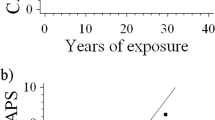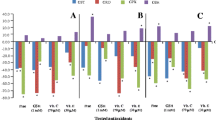Abstract
Agricultural practices are usually supported by several chemical substances, such as herbicides. Linuron and chlorbromuron are phenylurea herbicides largely used to protect crops from weeds, blocking photosynthesis by inhibition of the photosystem II complex. The former, also commercially known as lorox or afalon, is selectively used to protect bean and French bean plants, fennels, and celeriacs; the second, commercially known as maloran, is selectively used for carrots, peas, potatoes, soy sprouts, and sunflowers. Considering the widespread use of herbicides and, more generally, pesticides, it is important to clarify their involvement on human health, one of them concerning the possible direct or indirect effect on the genome of exposed populations. Here, we show that these herbicides are endowed by mutagenic properties, as demonstrated by an increased number of chromosomal aberrations (CAs) in two exposed Chinese hamster cell lines derived from ovary and epithelial liver, respectively. This was also confirmed by sister chromatid exchange (SCE) and micronucleus (MN) assays. Our present and previously obtained data clearly indicate that phenylurea herbicides must be used with great caution, especially for agricultural workers who use large amounts of herbicides during their work, and particular attention should be given to residues of these herbicides and their involvement in environmental pollution.


Similar content being viewed by others
References
Ahn MY, Bae HJ, Kim IS, Yoo EJ, Kwack SJ, Kim HS, Kim DH, Ryu KS, Lee HS, Kim LW, Kim I, Lee BM (2005) Genotoxic evaluation of the biocomponents of the cricket, Gryllus bimaculatus, using three mutagenicity tests. J Toxicol Environ Health - Part A 68:2111–2118. doi:10.1080/15287390500182537
Alavanja MC, Ward MH, Reynolds P (2007) Carcinogenicity of agricultural pesticides in adults and children. J Agromedicine 12(1):39–56. doi:10.1300/J096v12n01_05
Aliferis KA, Jabaji S (2011) Metabolomics—a robust bioanalytical approach for the discovery of the modes-of-action of pesticides: a review. Pestic Biochem Physiol 100(2):105–117. doi:10.1016/j.pestbp.2011.03.004
Allen-Hoffmann BL, Rheinwald JG (1984) Polycyclic aromatic hydrocarbon mutagenesis of human epidermal keratinocytes in culture. Proc Natl Acad Sci U S A 81(24 I):7802–7806. doi:10.1073/pnas.81.24.7802
Ames BN, McCann J, Yamasaki E (1975) Methods for detecting carcinogens and mutagens with the Salmonella/mammalian microsome mutagenicity test. Mutat Res 31(6):347–364. doi:10.1016/0165-1161(75)90046-1
Bolognesi C (2003) Genotoxicity of pesticides: a review of human biomonitoring studies. Mutat Res - Rev Mutat Res 543(3):251–272. doi:10.1016/S1383-5742(03)00015-2
Bolognesi C, Creus A, Ostrosky-Wegman P, Marcos R (2011) Micronuclei and pesticide exposure. Mutagenesis 26:19–26. doi:10.1093/mutage/geq070
Bouilly K, Bonnard M, Gagnaire B, Renault T, Lapègue S (2007) Impact of diuron on aneuploidy and hemocyte parameters in Pacific oyster, Crassostrea gigas. Arch Environ Contam Toxicol 52(1):58–63. doi:10.1007/s00244-005-0256-8
Bull S, Fletcher K, Booblis AR, Battershill JM (2006) Evidence for genotoxicity of pesticides in pesticide applicators: a review. Mutagenesis 21(2):93–103. doi:10.1093/mutage/gel011
Canna-Michaelidou S, Nicolaou AS (1996) Evaluation of the genotoxicity potential (by Mutatox test) of ten pesticides found as water pollutants in Cyprus. Sci Total Environ 193:27–35. doi:10.1016/S0048-9697(96)05322-3
Casida JE (2009) Pest toxicology: the primary mechanisms of pesticide action. Chem Res Toxicol 22(4):609–619. doi:10.1021/tx8004949
Chakraborty R, Mukherjee A (2009) Mutagenicity and genotoxicity of coal fly ash water leachate. Ecotoxicol Environ Saf 72(3):838–842. doi:10.1016/j.ecoenv.2008.09.023
Danford N, Wilcox P, Parry JM (1982) The clastogenic activity of dinitropyrenes in a rat-liver epithelial cell line. Mutat Res 105(5):349–355. doi:10.1016/0165-7992(82)90106-3
De Salvia R, Meschini R, Fiore M, Polani S, Palitti F, Carluccio MA, Turchi G (1988) Induction of sister-chromatid exchanges by procarcinogens in metabolically competent Chinese hamster epithelial liver cells. Mutat Res 207(2):69–75. doi:10.1016/0165-7992(88)90044-9
Dean BJ, Hodson-Walker G (1979) An in vitro chromosome assay using cultured rat-liver cells. Mutat Res 64(5):329–337. doi:10.1016/0165-1161(79)90125-0
DeMarini DM, Gudi R, Szkudlinska A, Rao M, Recio L, Kehl M, Kirby PE, Polzin G, Richter PA (2008) Genotoxicity of 10 cigarette smoke condensates in four test systems: comparisons between assays and condensates. Mutat Res - Genet Toxicol Environ Mutagen 650(1):15–29. doi:10.1016/j.mrgentox.2007.09.006
Duke SO (1990) Overview of herbicide mechanisms of action. Environ Health Perspect 87:263–271. doi:10.2307/3431034
Federico C, Motta S, Palmieri C, Pappalardo M, Librando V, Saccone S (2011) Phenylurea herbicides induce cytogenetic effects on Chinese hamster cell lines. Mutat Res 721:89–94. doi:10.1016/j.mrgentox.2010.12.013
Fenech M (2000) The in vitro micronucleus technique. Mutat Res 455(1–2):81–95. doi:10.1016/S0027-5107(00)00065-8
Fenech M (2006) Cytokinesis-block micronucleus assay evolves into a “cytome” assay of chromosomal instability, mitotic dysfunction and cell death. Mutat Res 600(1–2):58–66. doi:10.1016/j.mrfmmm.2006.05.028
Fenech M (2007) Cytokinesis-block micronucleus cytome assay. Nat Protoc 2(5):1084–104. doi:10.1038/nprot.2007.77
Fenech M, Chang WP, Kirsch-Volders M, Holland N, Bonassi S, Zeiger E (2003) HUman MicronNucleus project. HUMN project: detailed description of the scoring criteria for the cytokinesis-block micronucleus assay using isolated human lymphocyte cultures. Mutat Res 534(1–2):65–75. doi:10.1016/S1383-5718(02)00249-8
Fenoll J, Garrido I, Hellín P, Flores P, Vela N, Navarro S (2015) Use of different organic wastes as strategy to mitigate the leaching potential of phenylurea herbicides through the soil. Environ Sci Pollut Res 22(6):4336–49. doi:10.1007/s11356-014-3652-7
Gaines TA, Zhang W, Wang D, Bukun B, Chisholm ST, Shaner DL, Nissen SJ, Patzoldt WL, Tranel PJ, Culpepper AS, Grey TL, Webster TM, Vencill WK, Sammons RD, Jiang J, Preston C, Leach JE, Westra P (2010) Gene amplification confers glyphosate resistance in Amaranthus palmeri. Proc Natl Acad Sci U S A 107(3):1029–1034. doi:10.1073/pnas.0906649107
Goumenou M, Machera K (2004) Mixture of paraquat and linuron formulations examined for genotoxicity in Wistar rats by the in vivo micronucleus test evaluation by different statistical tests. J Environ Sci Health B 39:75–87. doi:10.1081/PFC-120027440
Grisham JW, Charlton RK, Kaufman DG (1978) In vitro assay of cytotoxicity with cultured liver: accomplishments and possibilities. Environ Health Perspect 25:161–171. doi:10.1289/ehp.7825161
Iype PT, Turner S, Siddiqi MS (1980) Markers for transformation in rat liver epithelial cells in culture. Ann NY Acad Sci 349:312–322. doi:10.1111/j.1749-6632.1980.tb29535.x
Kebeish R, Azab E, Peterhaensel C, El-Basheer R (2014) Engineering the metabolism of the phenylurea herbicide chlortoluron in genetically modified Arabidopsis thaliana plants expressing the mammalian cytochrome P450 enzyme CYP1A2. Environ Sci Pollut Res 21(13):8224–32. doi:10.1007/s11356-014-2710-5
Liu J (2001) Amount of a Urea Herbicide has been Ingested Within 1hour, there Principles. Handbook of Pesticide Toxicology. Krieger RI and Krieger WC editors, Elsevier p. 1521–1527
Morales-Flores F, King-Dìaz B, Aguilar ML, Lotina-Hennsen B (2014) Weeds and their mechanisms of resistance to herbicides. Handbook on Herbicides. Kobayashi D, Watanabe E editors. New York: Nova Science Publishers, p.29-54
Motta S, Federico C, Saccone S, Librando V, Mosesso P (2004) Cytogenetic evaluation of extractable agents from airborne particulate matter generated in the city of Catania (Italy). Mutat Res - Genet Toxicol Environ Mutagen 561(1–2):45–52. doi:10.1016/j.mrgentox.2004.03.008
Ouedraogo M, Baudoux T, Stévigny C, Nortier J, Colet JM, Efferth T, Qu F, Zhou J, Chan K, Shaw D, Pelkonen O, Duez P (2012) Review of current and “omics” methods for assessing the toxicity (genotoxicity, teratogenicity and nephrotoxicity) of herbal medicines and mushrooms. J Ethnopharmacol 140(3):492–512. doi:10.1016/j.jep.2012.01.059
Perry P, Wolff J (1974) New Giemsa method for the differential staining of sister chromatid. Nature 251:156–158
Powles SB (2008) Evolved glyphosate-resistant weeds around the world: lessons to be learnt. Pest Manag Sci 64(4):360–365. doi:10.1002/ps.1525
Seiler JP (1978) Herbicidal phenylalkylureas as possible mutagens I. Mutagenicity tests with some urea herbicides. Mutat Res/Genet Toxicol 58:353–359. doi:10.1016/0165-1218(78)90029-0
The Pesticide Manual – A World Compendium. Eighth edition (1987) Published by The British Crop Protection Council.
Torres SM, Walker DM, Carter MM, Cook DL Jr, McCash CL, Cordova EM, Olivero OA, Poirier MC, Walcker VE (2007) Mutagenicity of zidovudine, lamivudine, and abacavir following in vitro exposure of human lymphoblastoid cells or in utero exposure of CD-1 mice to single agents or drug combinations. Environ Mol Mutagen 48(3–4):224–238. doi:10.1002/em.20264
Turchi G, Carluccio MA, Oesch F, Gemperlein I, Glatt HR (1987) Characterisation of an epithelial nearly diploid liver cell strain from Chinese hamster able to activate promutagens. Mutagenesis 2:127–135. doi:10.1093/mutage/2.2.127
Acknowledgments
Work was supported by PRA-2011 to SS and FIR-2014 to VF from University of Catania. Authors thank the anonymous reviewers for constructive criticisms.
Author information
Authors and Affiliations
Corresponding author
Additional information
Responsible editor: Philippe Garrigues
Rights and permissions
About this article
Cite this article
Federico, C., Palmieri, C., Pappalardo, A.M. et al. Mutagenic properties of linuron and chlorbromuron evaluated by means of cytogenetic biomarkers in mammalian cell lines. Environ Sci Pollut Res 23, 17018–17025 (2016). https://doi.org/10.1007/s11356-016-6867-y
Received:
Accepted:
Published:
Issue Date:
DOI: https://doi.org/10.1007/s11356-016-6867-y




